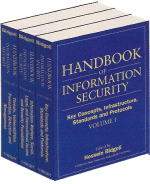Handbook of Information Security, Volume I: Key Concepts, Infrastructure, Standards and Protocols

More than 200 articles from over 200 leading experts, providing the benchmark resource for information security, network security, information privacy, and information warfare
Hossein Bidgoli
Hardcover
1120 pages
January 2006
From the Publisher:
The Handbook of Information Security is a definitive 3-volume handbook that offers coverage of both established and cutting-edge theories and developments on information and computer security. The 3 Volumes contain over 200 articles from over 200 leading experts, providing the benchmark resource for information security, network security, information privacy, and information warfare.
Key features:
- The Handbook provides researchers and managers with a solid coverage of the core technologies and applications in the information security field.
- Articles in the Handbook have been rigorously peer-reviewed by more than 1,000 experts chosen from around the world.
- The 3 volumes include more than 200 articles from over 200 leading experts.
Table of Contents in Volume I Include:
Part 1: Key Concepts and Applications related to Information Security
- Internet Basics
- Digital Economy
- Online Retail Banking: Security Concerns, Breaches, and Controls
- Digital Libraries: Security and Preservation Considerations
- E-Mail and Instant Messaging
- Internet Relay Chat
- Online Communities
- Groupware: Risks, Threats, and Vulnerabilities in the Internet Age
- Search Engines: Security, Privacy and Ethical Issues
- Web Services
- Electronic Commerce
- EDI Security
- Electronic Payment Systems
- Intranets: Principals, Privacy and Security Considerations
- Extranets: Applications, Development, Security and Privacy
- Business-to-Business Electronic Commerce
- Click-and-Brick Electronic Commerce
- Mobile Commerce
- E-education and Information
- Privacy and Security
- Security in E-Learning E-Government
- E-government Security Issues and Measures
- International Security Issues of E-Government
Part 2: Infrastructure for the Internet, Computer Networks and Secure Information Transfer
- Conducted Communications Media
- Routers and Switches
- Radio Frequency and Wireless Communications Security
- Wireless Channels
- Security in Circuit, Message, and Packet Switching
- Digital Communication
- Local Area Networks
- Wide Area and Metropolitan Area Networks
- Home Area Networking
- Public Network Technologies and Security
- Client/Server Computing: Principles and Security Considerations
- Peer-to-Peer Security
- Security Middleware
- Internet Architecture
- TCP/IP Suite
- Voice over Internet Protocol (VoIP)
- Security and Web Quality of Service
- Mobile Devices and Protocols
- Bluetooth Technology
- Wireless Local Area Networks
- Security in Wireless Sensor Networks
- Cellular Networks
- Mobile IP
- IP Multicast and its Security
- TCP over Wireless Links
- Air–Interface Requirements for Mobile Data Services
- Wireless Internet: A Cellular Perspective
- Security for Satellite Networks
- Security of Broadband Access Networks
- Ad hoc Network Security
Part 3: Standards and Protocols for Secure Information
- Transfer Standards for Product Security Assessment
- Digital Certificates
- Internet E-Mail Architecture
- PKI (Public Key Infrastructure)
- S/MIME (Secure MIME)
- PGP (Pretty Good Privacy)
- SMTP (Simple Mail Transfer Protocol)
- Internet Security Standards
- Kerberos
- IPsec: AH (Authentication Header) and ESP (Encapsulating Security Payload)
- IPsec: IKE (Internet Key Exchange)
- Secure Sockets Layer (SSL)
- PKCS (Public-Key Cryptography Standards)
- Secure Shell (SSH)
- Security and the Wireless Application Protocol (WAP)
- Wireless Network Standards and Protocol (802.11)
- P3P (Platform for Privacy Preferences Project)
About the Author: Hossein Bidgoli, Ph.D., is professor Management Information Systems at California State University. Dr. Bidgoli helped set up the first PC lab in the United States. he is the author of 43 textbooks, 27 manuals and over five dozen technical articles and papers on various aspects of computer applications, information systems and network security, e-commerce and decision support systems published and presented throughout the world. Dr. Bidgoli also serves as the editor -in-chief of the Internet Encyclopedia and the Encyclopedia of Information Systems. The Encyclopedia of Information Systems.
This volume is part of a 3 volume set including Volume 1, Key Concepts, Infrastructure, Standards and Protocols, Volume 2, Information Warfare, Social, Legal, and International Issues and Security Foundations and Volume 3, Threats, Vulnerabilities, Prevention, Detection, and Management.
Handbook of Information Security - Three Volume Set Includes:
- Volume I: Key Concepts, Infrastructure, Standards and Protocols;
- Volume II: Information Warfare, Social, Legal, and International Issues and Security Foundations
- Volume III: Threats, Vulnerabilities, Prevention, Detection and Management